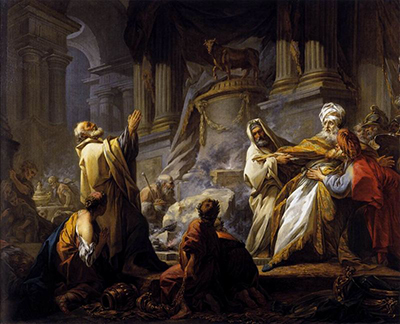 Buy Art Prints Now
Buy Art Prints Nowfrom Amazon
* As an Amazon Associate, and partner with Google Adsense and Ezoic, I earn from qualifying purchases.
Jeroboam Offering Sacrifice for the Idol from 1752 is a part of the collection of the École des Beaux-Arts in Paris. The painting is over a metre tall and wide, typical of artist Fragonard.
This historical artwork displays the artist's incredible control over lighting and this perhaps explains how it came to the attention of the French academics. Jeroboam himself was described in the Books of Kings which explains how he was the initial king in a new collective of tribes who would rule over a kingdom in modern-day Israel. The scene in front of us captures the moment when confusion ensues as a prophet is placed under arrest for speaking out of turn. A miraculous series of events unfold which provided the inspiration for this technically impressive piece. Fragonard produced a number of paintings in this standard size of 115cm tall by 145cm wide. He also produced a number of pendant pieces which sat alongside each other in these same dimensions.
Fragonard produced a number of history-based artworks during his career but he remains most famous for his scenes of domestic life where commentary would be made on the lives of men and women within society. Those tended to use loosely delivered scenes of foliage in which charming figures would dance and play in an innocent manner. Jeroboam Offering Sacrifice is, therefore, a far more serious artwork with a clearer narrative and this style was perhaps prefered by the academics who would always side with the more traditional styles.
This fine artwork can be found at the École des Beaux-Arts in Paris and was itself awarded the Grand Prix de l'Académie Royale when unveiled in 1752. The École des Beaux-Arts itself is a charming arts venue which remains one of the more prominent locations for art fans within the French capital. It was established as early as 1682, not long after the Italian and Northern Renaissance movements had taken hold and now boasts a collection that runs into the thousands. As well as a fine collection of art, this institution has also helped developed some of the biggest names in European art, including the likes of Jean-François Millet, Jacques-Louis David, Eugène Delacroix and Edgar Degas, with Jean-Honoré Fragonard also himself being amongst this star-studded list of alumni.



